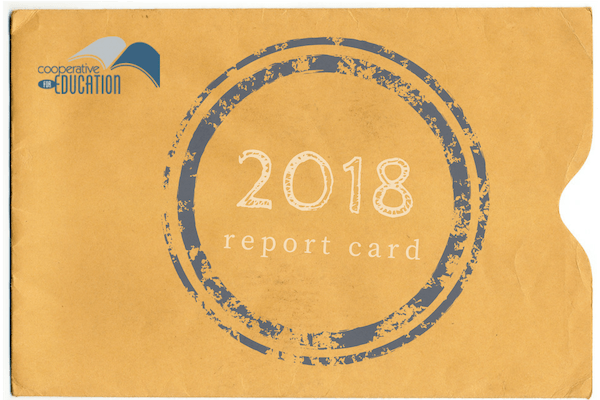
Happy 2019!
As you guys know, we here at CoEd are dedicated to data. We don’t want to simply deliver kick-butt programs—we want some hard numbers to tell us if they’re working! (In fact, we’re kinda nerds about it…)
To that end, every year we test each of our programs to see what’s working at 100% and where we can focus our attention to get even better results. This year, the numbers we found blew us away, so we thought we’d present you with a little report card on how the programs you invest in are breaking the cycle of poverty.
Scroll down to nerd out with us for a minute!
Culture of Reading Program (CORP)
Kids in CORP classrooms are learning twice as much as kids in regular classrooms.
- CORP Classroom
- Regular Classroom
CORP trains primary-school teachers to teach reading in a way that’s fast, fun, and effective.
Primary Goal: To get kids reading fluently at 60 words per minute by the end of the second grade.
In partnership with researchers at the University of Cincinnati, we designed a randomized controlled trial evaluation of CORP. Researchers analyzed the reading comprehension scores of first-graders who took an internationally recognized standardized reading test, comparing pre- and post-data from students at 7 CORP schools with their peers at 8 randomly selected control schools.
Kids in CORP classrooms are learning twice as much as kids in regular classrooms.
This is great news for the kids in the CORP program! But it also means that by-and-large, normal Guatemalan classrooms are still not great places to learn to read. So we need to keep spreading CORP! Literacy is absolutely critical to breaking the cycle of poverty, since it opens the door to further education and life opportunities.
Psst—we also know from previous studies that 30% fewer kids fail their grade level when they are learning with CORP.
Textbook Program
16% fewer students drop out when they have textbooks.
%
fewer students drop out
The Textbook Program provides textbooks to rural middle schools and trains teachers to use them in their classrooms.
It also requires parents to invest a small monthly fee so that the community can buy new textbooks when the original books wear out.
We analyzed dropout data at 38 Textbook Program schools, each over a span of 10 years: starting 5 years before the program was introduced at the school and ending 5 years after the program was introduced.
16% fewer students drop out when they have textbooks.
This is a statistically significant result, indicating that the Textbook Program is keeping more kids in school!
With textbooks, classes are a lot less boring and a lot more valuable, because teachers don’t have to spend time dictating information or writing it on the board for their students to copy down in their notebooks. Instead, the students just flip open their textbooks. This means kids have more time to ask questions, think big, and get creative with what they’re learning. And that means school is cool again! (Well, maybe.)
What’s more, when schools have textbooks, parents are less likely to pull their kids out of school to work, because the value of the education that their kids are receiving is greater.
Psst—we also know from our ongoing records that 98% of schools that have been active in the Textbook Program for more than 5 years have renewed their books at least once through the revolving fund.
Computer Program
35% fewer students drop out when they have computer class.
%
fewer students drop out
The Computer Program provides computers to rural schools and gives extensive training and curriculum guidance to the computer teachers at those schools.
It also requires parents to invest a small monthly fee so that the community can buy new computers when the original computers wear out.
We analyzed dropout data at 24 Computer Program schools, each over a span of 10 years: starting 5 years before the program was introduced at the school and ending 5 years after the program was introduced.
35% fewer students drop out when they have a CoEd computer lab.
This is a statistically significant result, indicating that the Computer Program is keeping even more kids in school!
Technical skills are very valuable in Guatemala, just like they are in other countries. But so many rural schools lack computers that kids often pay extra money to attend classes at outside computer academies. If they can’t afford to do that, they go without learning this essential skill.
The Computer Program changes the dynamic by making technology accessible and affordable for rural families. And as the value of education increases, it becomes more important to parents and students to stay in school.
Psst—we also know from previous studies that 95% of kids who graduate from the Computer Program continue their education or find a job.
Rise Youth Development Program
8 out of 10 Rise Program students graduate, even though all of the cards are stacked against them.
%
of students would graduate without Rise
%
of students graduate with Rise
The Rise Program provides
- scholarships,
- social support and psychological support, and
- youth development opportunities
to at-risk students in middle and high school.
It identifies students who would likely drop out of school without this support.
Looking at data from the last five years, we analyzed the number of Rise Program students who graduated from high school, compared to the total number of students who had entered the program with a graduation date in those years.
Many of these students entered the program in seventh grade, while others entered in later grades.
8 out of 10 Rise Program students graduate, even though all of the cards are stacked against them.
Without the Rise Program, none of the students in it would graduate from high school. How do we know? Because our program staff select students who are about to drop out of school and offer those students entry into the program. These are the kids who have almost everything working against them: from their economic situation, to their home life, to their broader context where things like alcoholism, teen pregnancy, and gang violence are the norm. Staying in school every day is like climbing Mt. Everest for these kids. You and me? We’re the sherpas.
Psst—we also know from a previous study that over half of Rise Program graduates who have younger siblings help to pay for them to stay in school too.

Nice quick update
Thanks
Thanks, Ed!
I would be more interested in end results, i.e., how many of the students that go through either program actually move on to a non-subsistence farming lifestyle. CoED has been in action enough years for such a study to be doable.
Hi, Craig. Thank you for your suggestion–we are really interested in looking at that data too. We have actually studied the Rise Program and Computer Program and found that
– 90% of Rise Program graduates go on to get a job in the formal sector or further their education beyond high school
– 95% of Computer Program graduates go on to find work or further their education in high school (The Computer Program operates at the middle school level, as you know.)
We plan to continue measuring this result, because you are right–that is the true end goal. Thanks for all you do, Craig.
And results for the textbook program: Same question
Hi Craig,
We would love to analyze these results for the Textbook Program as well, but as of now we don’t have the budget to take on such a logistically challenging study. There are nearly 25,000 students in the program this year alone. If you know of someone who could help us conduct such a study, we’d be thrilled! Thanks again.
Great report. Keep up the excellent work!
Thanks, Ted! 🙂 We plan on it.
We have such fond memories of the trip handing out books and initiating computer rooms so long ago! You do such a GREAT work.. what a vision. Your success is so encouraging. Bringing hope for a better education and a better job and a better life. You change the world.
FYI, we still go to Latin America to provide dentistry to the hurting poor. After going to a home for sexually abused girls in Nicaragua the last 6 years, we have to delay, cancel our plans to return due to the terrible situation there, now being called a Reign of Terror. Please keep Nicaragua in your prayers. So we are concentrating our resources and time to what is near… Mexico. At the end of this month we will return to Puerto Penasco (Rocky Point) to provide dental care to the people in a large, very poor area. Most live in shanties built of found materials.
Keep up the great work,… you continue to inspire us. Dick and Judy Martin
Thank you so much, Dick! We are inspired by *your* dedication to serving people in need with your skills and resources. We will certainly keep Nicaragua in our thoughts and prayers… So great to get an update from you. Hope you and Judy are very well!